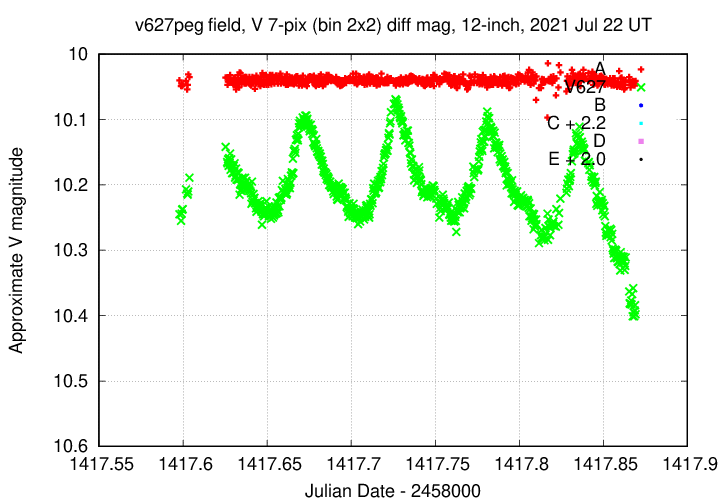
On the night of Jul 21/22, 2021, under fair conditions, I acquired images of the cataclysmic variable star V627 Peg. One can find information about it at
This was my first attempt to measure this star. The results are pretty good, in large part due to its brightness (V = 10.3 or so).
Christian Knigge is soliciting observations of this cataclysmic variable star at all wavelengths. The AAVSO has advertised for optical measurements, and I'm joining the effort.
The main setup was:
Notes from the night:
The object is located at
RA = 21:38:06.63 Dec = +26:19:56.0 (J2000)
A chart of the field is shown below. The size of the chart is about 31 x 26 arcminutes.

I've marked the location of several comparison stars as well. See
I'll use star "D" to shift my instrumental magnitudes to the V-band scale. It has a V-band magnitude (according to AAVSO chart X26768AQ) of 12.002, and (B-V) = 0.692.
I took a photo of the finder TV's screen when pointing to this target; this could be a useful reference for the future:

The sky value shows small clouds coming late in the run.

The FWHM graph below shows smooth changes, due to a gradual drop in temperature and due to the change in airmass.

Using aperture photometry with a radius of 7 pixels in a V filter (binned 2x2, each pixel is 1.24 arcsec, so a radius of 8.7 arcsec), I measured the instrumental magnitudes of a number of reference stars and the target. Following the procedures outlined by Kent Honeycutt's article on inhomogeneous ensemble photometry, I used all stars available in each image to define a reference frame, and measured each star against this frame.
Sigma-vs-mag plots show that the floor was about 0.006 mag after I removed images with large outliers.

The change in zeropoint was driving by airmass.

Here is the light curve of the object and several field stars in the V filter; I've shifted the instrumental magnitudes so that star "D" = 000-BJV-433 on AAVSO chart X26767AK has the value given by AAVSO as its V-band magnitude.

Here's a closeup.

I have submitted these measurements to the AAVSO, CBA, and VSNet.
You can download my measurements below. A copy of the header of the file is shown to explain the format.
# Measurements of V627Peg made at RIT Obs, UT 2021 Jul 22, # in fair conditions, # by Michael Richmond, # using Meade 12-inch LX200 and ATIK 11000. # Exposures 15 seconds long, V filter. # Tabulated times are midexposure (FITS header time - half exposure length) # and accurate only to +/- 1 second (??). # 'mag' is a differential magnitude based on ensemble photometry # using a circular aperture of radius 7 pix = 8.8 arcseconds. # which has been shifted so AAVSO 000-BJV-433 has mag=12.002 # which is its V-band magnitude according to AAVSO chart X26767AK. # # UT_day JD HJD mag uncert Jul22.09782 2459417.59782 2459417.60145 10.245 0.007 Jul22.09881 2459417.59881 2459417.60244 10.255 0.007 Jul22.09913 2459417.59913 2459417.60276 10.244 0.007
Last modified 7/23/2021 by MWR.